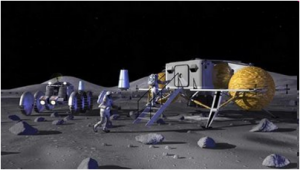In July 1980 the Vietnamese astronaut Phạm Tuân took samples of azolla to the Soviet Salyut-6 space station to determine its potential use in space travel and planetary colonization
Both of these habitats require closed-loop life support systems (CLLS), also known as controlled ecological life support systems (CELSS).
Azolla is ideally suited for CELSS due to the limited amount of available space in these habitats. azolla only needs a water depth of 2 to 3 centimeters (about one inch), so that it can be grown in multi-layered frames that require less space than other plants. This gives it an advantage over plants such as the sweet potato, which has also been proposed as for use in space stations because all of the plant is edible. However, plants such as the sweet potato require a relatively large growing area and they take several months to mature, as do rice and wheat, two of the other candidates for food in space. This contrasts with azolla’s ability to double its biomass in just two to three days.
Phạm Tuân’s results were encouraging and other teams of scientists have subsequently investigated azolla’s potential to both provide food and remove waste products including urine purification in space and planetary CELSS. These studies were mainly based in China, Japan and Russia:
- The College of Life Science, Peking University, Beijing, China
- The Azolla Research Center, Fujian Academy of Agricultural Sciences, China
- The China Helicopter Design Institute, Jingdezhen, China
- Institute of Space and Astronautical Science, JAXA, Sagamihara, Kanagawa, Japan
- National Azolla Research Center, Fujian, China
- Obayashi Corporation, Minato-ku, Tokyo, Japan
- Nagoya Women’s University, Mizuho-ku, Nagoya, Japan
- Gonbeh Institute of Advanced Study, Yokahama, Japan
- Institute of Environmental Microbiology, Machida, Tokyo, Japan
- Okayama University, Tsushimanaka, Okayama, Japan
- Space Agricultural Task Force., Japan
- Institute of Molecular Biology and Genetics of the Ukraine, SSR Academy of Sciences
- SSC-Institute of Biomedical Problems RAS, Moscow, Russia
To give just one example, a Chinese team led by Xiaofeng Liu conducted experiments to determine the capacity of azolla to provide oxygen within an “azolla-human” ecosystem of CELSS. Their results showed that in a CELSS, azolla plants with a growing area of 16 square meters were able to provide the oxygen used by two adults (Liu et al., 2008).
Few western scientists have published on this intriguing use of azolla other than Francisco Carrapiço at Lisbon University (Carrapiço, 2001) who also recommended azolla’s use for space and planetary colonization.
Based on the results of these studies, it is not difficult to visualize enclosed environments in space or on the surface of other planets containing layers of shallow trays filled with the green azolla plants providing the human inhabitants with life-giving oxygen and food.
This would be ideal for domed habitats on the moon or other planets – a crucial step towards our exploration and colonization of space.




